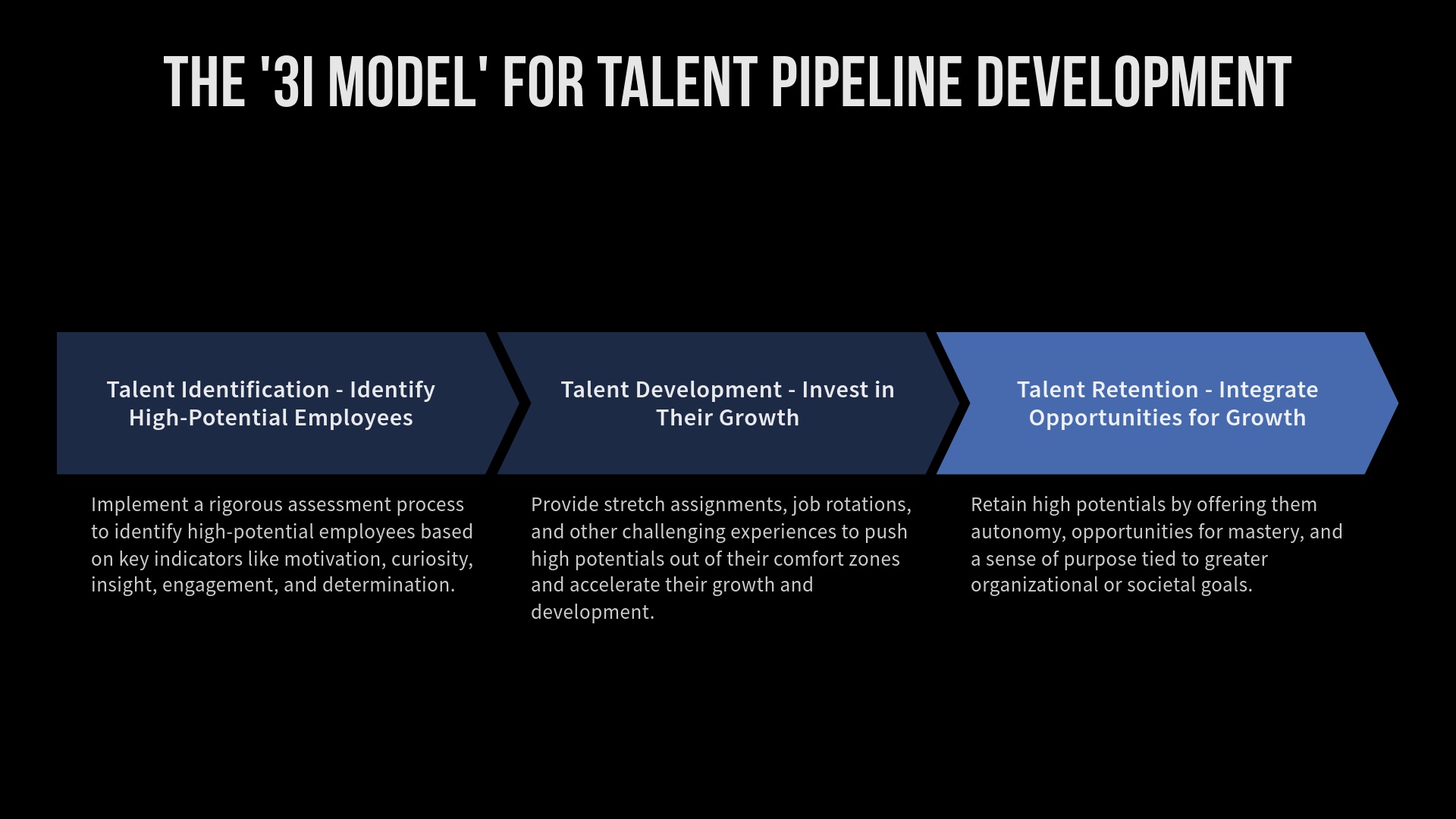Developing a Talent Pipeline: Building Future-Ready Leaders
Dec 29, 2024
Scaling your business demands more than just vision—it requires people who can step up, adapt, and lead as your organization grows. A well-developed talent pipeline isn’t just a nice-to-have; it’s a critical foundation for sustained success. Yet many organizations, from SMBs to Fortune 500 companies, struggle to ensure they have the right talent in place when it’s most needed.
Let’s explore how to overcome this challenge using the 3I Model for Talent Pipeline Development, a framework designed to future-proof your workforce by identifying high-potential employees, investing in their growth, and retaining them through meaningful opportunities. Let's get into it!
Why Talent Pipelines Matter Now More Than Ever
The global workforce is facing unprecedented pressures. As industries become more complex and competitive, the traditional markers of leadership—past performance and current skills—are no longer sufficient. According to surveys highlighted in my analysis, 63% of CEOs are concerned about future skills availability, and 56% report critical gaps in leadership readiness. With nearly half of senior leaders eligible for retirement in the next two years, organizations cannot afford weak or outdated talent strategies.
The solution? A focus on potential—the ability to adapt, grow, and succeed in increasingly complex roles. This shift is embodied in the 3I Model, which takes a forward-looking approach to leadership development.
Breaking Down the 3I Model for Talent Pipeline Development

1. Identify High-Potential Employees
The first step in building a talent pipeline is spotting individuals who exhibit the qualities necessary to thrive in leadership roles. These include:
- Motivation: A fierce commitment to excel while prioritizing collective success.
- Curiosity: A drive to learn, adapt, and embrace change.
- Insight: The ability to process information and recognize new opportunities.
- Determination: Resilience in the face of challenges and setbacks.
- Engagement: The skill to connect and inspire others toward a shared vision.
Action Step: Use tools like the 9-Box Talent Grid to evaluate employees across two dimensions: performance and potential. Schedule quarterly talent reviews to ensure you have an updated, actionable understanding of your workforce.
Real-World Example: One multinational company implemented a rigorous assessment process that included these five qualities. Within 12 months, they identified 15 high-potential employees who later spearheaded key transformation projects.
2. Invest in Their Growth
Once high-potential employees are identified, the next step is nurturing their growth through deliberate development opportunities. This involves:
- Structured mentorship programs with senior leaders.
- Leadership workshops focused on building decision-making and strategic thinking skills.
- Rotational assignments that expose employees to different functions and challenges.
Action Step: Establish a development program with milestones tied to specific business goals. For instance, stretch assignments can be used to challenge high potentials while providing measurable outcomes.
Real-World Example: A tech firm scaling from $50M to $150M in revenue launched a rotational leadership program. This not only accelerated the readiness of future leaders but also improved retention rates among high potentials by 25%.
3. Integrate Opportunities for Growth
The final component of the 3I Model is creating meaningful opportunities that integrate leadership aspirations into the broader organizational strategy. High-potential employees thrive when they are:
- Given autonomy to make impactful decisions.
- Challenged with high-stakes projects that align with their career goals.
- Connected to a greater purpose, whether organizational or societal.
Action Step: Pair emerging leaders with key organizational initiatives, such as leading cross-functional teams or spearheading innovation projects. This not only develops their skills but also ensures alignment with long-term business objectives.
Real-World Example: One of my clients assigned their top performers to lead a digital transformation initiative. The experience prepared them for future executive roles while delivering a 30% increase in operational efficiency.
Overcoming Common Challenges
- Leadership Gaps: By proactively identifying and developing talent, you reduce the risk of scrambling to fill critical roles during growth phases.
- Employee Retention: High-potential employees are less likely to leave when they see clear paths for growth and meaningful engagement.
- Scalability: With a future-ready workforce, your business can scale confidently without disruption.
Closing Thoughts: Future-Proofing Your Organization
The talent you cultivate today will define the trajectory of your business tomorrow. A robust talent pipeline built on the 3I Model ensures that your organization is prepared to meet the challenges of scaling head-on, with the right leaders ready to step up when it matters most.
Sam Palazzolo
Real Strategies. Real Results.
SUBSCRIBE FOR WEEKLY BUSINESS SCALING STRATEGIES
REAL STRATEGIES. REAL SOLUTIONS.
We respect your privacy. Unsubscribe at any time.
